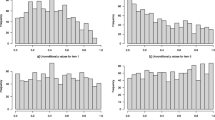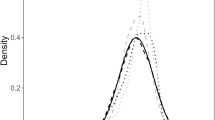Abstract
A new algorithm for obtaining exact person fit indexes for the Rasch model is introduced which realizes most powerful tests for a very general family of alternative hypotheses, including tests concerning DIF as well as model-deviating item correlations. The method is also used as a goodness-of-fit test for whole data sets where the item parameters are assumed to be known. For tests with 30 items at most, exact values are obtained, for longer tests a Monte Carlo-algorithm is proposed. Simulated examples and an empirical investigation demonstrate test power and applicability to item elimination.
Similar content being viewed by others
References
Andersen, E. B. (1973). A goodness of fit test for the Rasch model.Psychometrika, 38, 123–140.
Bedrick, E. J. (1997). Approximating the conditional distribution of person fit indexes for checking the Rasch model.Psychometrika, 62, 191–199.
Fischer, G. H. (1995a). Derivations of the Rasch model. In G. H. Fischer & I. W. Molenaar (Eds.),Rasch models. Foundations, recent developments, and applications (pp. 15–38). New York: Springer-Verlag.
Fischer, G. H. (1995b). The linear logistic test model. In G. H. Fischer & I. W. Molenaar (Eds.),Rasch models. Foundations, recent developments, and applications (pp. 131–155). New York: Springer-Verlag.
Fischer, G. H. (1995c). Some neglected problems in IRT.Psychometrika, 60, 449–487.
Folks, J. L. (1984). Combination of independent tests. In P. R. Krishnaiah & P. K. Sen (Eds.),Handbooks of statistics, Vol. 4 (pp. 113–121). North Holland: Amsterdam.
Glas, C. A. W. & Verhelst, N. D. (1995). Testing the Rasch model. In G. H. Fischer & I. W. Molenaar (Eds.),Rasch models. Foundations, recent developments, and applications (pp. 69–95). New York: Springer-Verlag.
Holland, P. W., & Thayer, D. T. (1988). Differential item functioning and the Mantel-Haenszel procedure. In H. Wainer & H. I. Braun (Eds.),Test validity. Hillsdale, NJ: Lawrence Erlbaum.
Klauer, K. C. (1991). An exact and optimal standaridized person test for assessing consistency with the Rasch model.Psychometrika, 56, 213–228.
Klauer, K. C. (1995). The assessment of person fit. In G. H. Fischer & I. W. Molenaar (Eds.),Rasch models. Foundations, recent developments, and applications (pp. 97–110). New York: Springer-Verlag.
Lehmann, E. L. (1986).Testing statistical hypotheses. New York: Wiley.
Li, M. F., & Olejnik, S. (1997). The power of Rasch person-fit statistics in detecting unusual response patterns.Applied Psychological Measurement, 21, 215–231.
Liou, M., & Chang, C. H. (1992). Constructing the exact significance level for a person fit statistic.Psychometrika, 57, 169–181.
Mehta, C., & Patel, N. (1983). A network algorithm for performing Fisher's exact test inr ×c contingency tables.Journal of the American Statistical Association, 78, 427–434.
Molenaar, I. W. (1995). Estimation of item parameters. In G. H. Fischer & I. W. Molenaar (Eds.),Rasch models. Foundations, recent developments, and applications (pp. 39–51). New York: Springer-Verlag.
Molenaar, I. W., & Hoijtink, H. (1990). The many null distributions of person fit indexes.Psychometrika, 55, 75–106.
Neyman, J., & Pearson, E. S. (1933). On the problem of the most efficient tests of statistical hypotheses.Philosophical Transactions of the Royal Society, Series A, 231, 289–337.
Ponocny, I. (1996).Kombinatorische Modelltests für das Rasch-Modell [Combinatorial goodness-of-fit tests for the Rasch model]. Unpublished doctoral dissertation, University of Vienna.
Ponocny, I., & Ponocny-Seliger, E. (1999).T-Rasch 1.0. Groningen: ProGAMMA.
Rao, C. R. (1973).Linear statistical inference and its applications (2nd ed.). New York: Wiley.
Rasch, G. (1960).Probabilistic models for some intelligence and attainment tests. Kopenhagen: Danish Institute for Educational Research.
Stephens, M. A. (1986). Tests for the uniform distribution. In R. B. D'Agostino & M. A. Stephens (Eds.),Goodness-of-fit techniques (pp. 331–366). New York: Dekker.
Author information
Authors and Affiliations
Corresponding author
Additional information
The author wishes to thank Elisabeth Ponocny-Seliger and the reviewers for many helpful comments. All exact goodness-of-fit tests proposed in this article are implemented in the menu-driven program T-Rasch 1.0 by Ponocny and Ponocny-Seliger (1999) which can be obtained from ProGAMMA (WWW: http://www.gamma.rug.nl) and also performs nonparametric tests.
Rights and permissions
About this article
Cite this article
Poncny, I. Exact person fit indexes for the rasch model for arbitrary alternatives. Psychometrika 65, 29–42 (2000). https://doi.org/10.1007/BF02294184
Received:
Revised:
Issue Date:
DOI: https://doi.org/10.1007/BF02294184




